A
Auto Express
Guest
A number of van manufacturers have been focussing more and more on electric vans of late, spying a real growth market. There are already a handful of electric vans for sale in the UK today from makers such as Renault, Nissan, Peugeot and Citroen, while Mercedes and VW will be joining the fray in the coming months and years.
The electric van is gaining popularity because local authorities are introducing tougher legislation against polluting vehicles in urban areas, and an electric van is a good way of circumventing this legislation and cut running costs. Business users also benefit from favourable tax rates for electric vans to offset the high initial purchase price, and this includes up to £8,000 off list price from the Government Plug-in Van Grant.
Electric vans work best for fleets that cover short distances and so-called 'last-mile' delivery services. These companies largely operate in urban areas and do multiple stops on a route from the depot, while the very latest vans offer the kind of telematics that allow fleet operators to optimise routes so that battery range is less of a concern.
Current electric vans are based on existing van running gear with the electric system replacing the diesel or petrol engine and fuel tank. Constant improvements in battery technology mean an electric van has increased range capability, so it should be able to do a day's work without having to be recharged. Once the van is back at the depot, it can then be charged overnight at a relatively low cost when compared to filling up with diesel or petrol.
While small electric vans were the first to hit the road, manufacturers have now turned to electrifying the largest vans in their ranges. That's because research has revealed that last-mile van users are focused on cargo volume rather than maximum payload, and the best way for manufacturers to offer this is by offering large electric vans.
With new models arriving in the coming months that offer more tech than ever before, we've rounded up the electric vans that are on sale now and are on the way, to help you choose the right electric van for you.
Citroen Berlingo Electric/Peugeot Partner Electric
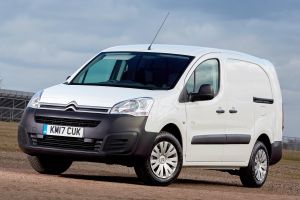
While the all-new Citroen Berlingo Van and Peugeot Partner are now in showrooms, the electric versions are still based on the older models. Unfortunately, that means they use old technology, so can't match rivals for driving range, payload, cargo volume or performance.
The Berlingo and Partner Electrics come in a choice of L1 or L2 body lengths, with the latter adding an additional 25cm of bodywork behind the rear wheels to create an extra 0.4 cubic metres of load space. Payload is 636kg for the L1 model and 552kg for the L2, although both are well behind the payload range of the now-discontinued combustion engined models (ranging from 648-856kg).
PSA Peugeot Citroen will be producing an electric version of the new Partner and Berlingo Van, but this will not appear until the end of 2019 at the earliest, and of course these will probably be joined by an electric version of the Vauxhall Combo van, which also shares the same platform.
Ford Transit Custom PHEV
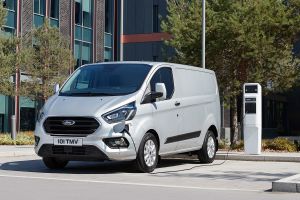
While it's not a pure electric model, the plug-in Ford Transit Custom PHEV garners interest because Ford's mid-sized van is the UK's best-seller, and this is Ford's first foray into electrification for its commercial vehicles.
The Transit Custom PHEV features a 1.0-litre three-cylinder EcoBoost turbo petrol engine that works as a generator to charge the 14kWh battery and electric motor. This gives the Transit Custom a range of 30 miles on electric power, while the engine recharges the battery when necessary.
Inside, the PHEV has the same cargo volume as the standard Transit Custom, at six cubic metres in standard wheelbase form, while a payload in excess of a tonne is also promised.
LEVC Van
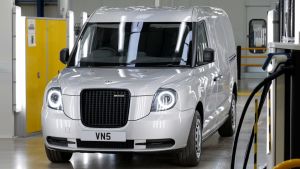
The London Electric Vehicle Company (LEVC) is well on the way to adding a second vehicle to its line-up to join its TX taxi. The new van will use the same running gear as the taxi, so will have a large battery and a small petrol engine to extend its range, much like the Transit Custom PHEV (above). But the van will get a more conventional look than the taxi, as it will ditch the retro-inspired front end and tail of that model in favour of something more reserved.
Expect a typical van set-up, with sliding side doors and rear access, too, although the taxi's tight turning circle could be retained to help the LEVC van in the urban areas it will be designed to tackle.
Mercedes eSprinter

Mercedes is pushing ahead with its electric van plans on two fronts, with the eSprinter and eVito. The larger Sprinter model will be the second to arrive in 2020, but will use similar tech to the Vito.
The eSprinter is based on the front-wheel-drive version of the award-winning Sprinter panel van, and the addition of an electric drive system hasn't impacted on that model's vast 10.5 cubic-metre load area. Like all electric vans, the motor is up front where the engine would sit, while the battery pack is located under the floor. Mercedes fits this into a steel cage to help protect it from impact in the even to an accident.
That battery will be offered in 41kWh or 55kWh forms, which means a driving range of 71 or 93 miles, which Mercedes claims is enough for a days' work doing 'last mile' deliveries. We tried a prototype which featured a series of driving modes that increase or lower the braking resistance of the electric motor, with the strongest setting proving effective enough that you could drive this van on one pedal if you wanted.
Mercedes eVito
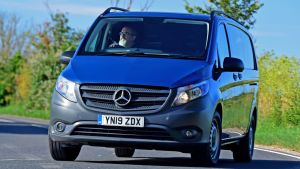
As the eVito uses the same running gear as the eSprinter in a smaller, lighter package, it means the eVito has an all-electric range of 93 miles as standard. Power comes from an 84kW electric motor, and its instant torque and quiet power delivery mean it's a far more enjoyable and refined van to drive than a diesel Vito with the same power output.
There are two body lengths offered, but just like the eSprinter, the front-wheel-drive eVito doesn't suffer a drop in cargo volume with the addition of the electrical system, although payload weights are lower to offset the extra 300kg added by the battery pack.
And like the eSprinter, the eVito comes with a suite of connected services developed by Mercedes and uses the company's PRO fleet management software, allowing operators to plan and change routes according to battery life and traffic hold-ups.
Nissan eNV200
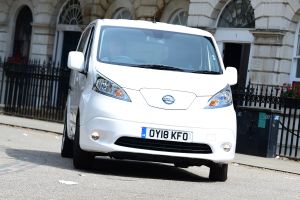
Nissan pioneered electric drive for the masses with the Leaf, and the eNV200 shares much of its electric drive system with the hatchback. And with the arrival of the Leaf Mk2 in 2018, the eNV200 also benefitted from the car's new battery and electric motor to deliver improved range and performance.
There's a 40kWh battery under the load floor, which gives the van a theoretical range of 187 miles, while the Leaf's suite of pre-heating and cabin prep tech is offered to get the maximum mileage from your van. The eNV200 has the largest cargo volume of any small electric van on sale, too, at 4.2 cubic metres. There's just the one body style, though.
The eNV200 comes in two-seat van guise and also as a seven-seat Combi MPV. The latter has seen use as a taxi in the UK, with operators reporting excellent reliability and more than enough battery range for most trips, while passengers are ferried around in silent comfort.
Renault Kangoo Z.E. 33
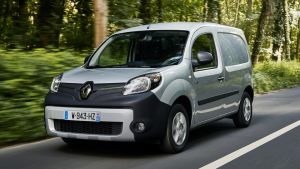
Price from: £29,040
On sale: Now
Electric range: miles
Cargo volume: 1.3-4.0 cubic metres
The Kangoo Z.E. mixes the van tech of the Kangoo compact van with the battery and electric motor from the Zoe, and what really sets it apart from its small electric van rivals is the number of variants that Renault offers. There are standard and Maxi van body lengths, but Renault also offers Crew Van and Crew Cab bodies. The last two have a second row of seats in the back, while the Crew Cab also adds a multi-positional bulkhead, so you can fold the seats away to create more load space when you need it.
Like the Zoe, Renault has constantly developed the Kangoo's battery tech and electric motor. So while the van itself is pretty basic and feels dated even by van standards, you can at least travel further and faster than ever, with a quoted range of 170 miles. That's under the older NEDC test: Renault also provides expected range mileages that vary between 125 miles in the summer to as little as 75 miles in the winter.
Renault Master Z.E.
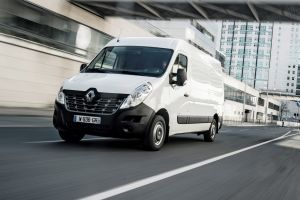
Like rivals Mercedes and Volkswagen, Renault has gone large with its next electric van. With the largest Kangoo Maxi Z.E. coming in at 4.0 cubic metres and the smallest Master Z.E. at 8.0 cubic metres, it was felt that a Trafic Z.E. to sit in between wouldn't be necessary, especially as buyers of electric vans are keen to get as much cargo volume for their money as possible.
Surprisingly, the Master Z.E. shares its running gear with the Kangoo Z.E., with the same electric motor fitted. This means performance is acceptable rather than rapid, but while Renault quotes a 124-mile electric range in test conditions (NEDC), it's honest about real-world range, offering an achievable maximum of 75 miles when it's warm, but only 50 miles in the cold.
Still, like the standard Master, there are short, medium and long wheelbase versions of the Z.E. in low and medium roof heights, plus you can even get one of Renault's professional chassis cab conversions in Z.E. guise, making the Master Z.E. the option to go for if you want a bespoke electric van for a specific job.
Volkswagen e-Crafter
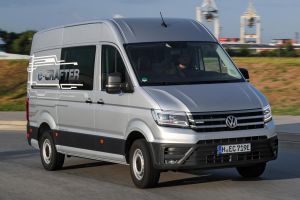
Like the eSprinter, the e-Crafter mixes existing van tech with electric power. In this instance, the e-Crafter gets the same electric motor as the e-Golf, with a 134bhp power output. And like the eSprinter, the front-wheel-drive set-up means the electrical system doesn't encroach on the load area. That means payloads from 1-1.75 tonnes, and a 10.7 cubic-metre cargo volume.
Unlike the Renault Master Z.E., there's just one body style available, but the full suite of safety systems from the diesel Crafter is carried over, and the standard van's nimble handling is largely retained, too. Add in the electric motor's 290Nm of torque, and the e-Crafter promises good performance, while the 40kWh battery offers a realistic range of 107 miles.
Volkswagen e-Transporter/e-Caddy
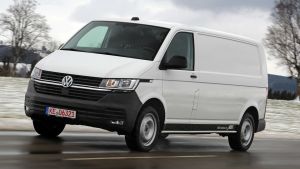
While the e-Crafter was an in-house VW project, the e-Transporter and e-Caddy have been created with the assistance of German tuning company Abt. While Abt is more famous for running motorsport programmes for Audi and VW in touring cars and more recently the Formula E single seater series, the e-van project sees it take a different approach with electric drive.
Abt takes the standard versions of the Caddy small van and mid-size T6.1 Transporter and fits the electric drive at its own factory. This means that while the e-Crafter only comes in one body style, there's the option of adding electric drive to a wide range of body styles for the two smaller vans. Indeed, trials are taking place for taxi versions of the e-Caddy and e-Transporter, and you probably shouldn't rule out an e-California electric camper van based on the T6.1, either.
The e-Transporter has a range of 82 miles courtesy of a 37.3kWh battery.
Check out the best small vans to buy on our sister site Buyacar...
Continue reading...
The electric van is gaining popularity because local authorities are introducing tougher legislation against polluting vehicles in urban areas, and an electric van is a good way of circumventing this legislation and cut running costs. Business users also benefit from favourable tax rates for electric vans to offset the high initial purchase price, and this includes up to £8,000 off list price from the Government Plug-in Van Grant.
- SEE MORE Best medium panel vans to buy 2020
Electric vans work best for fleets that cover short distances and so-called 'last-mile' delivery services. These companies largely operate in urban areas and do multiple stops on a route from the depot, while the very latest vans offer the kind of telematics that allow fleet operators to optimise routes so that battery range is less of a concern.
Current electric vans are based on existing van running gear with the electric system replacing the diesel or petrol engine and fuel tank. Constant improvements in battery technology mean an electric van has increased range capability, so it should be able to do a day's work without having to be recharged. Once the van is back at the depot, it can then be charged overnight at a relatively low cost when compared to filling up with diesel or petrol.
While small electric vans were the first to hit the road, manufacturers have now turned to electrifying the largest vans in their ranges. That's because research has revealed that last-mile van users are focused on cargo volume rather than maximum payload, and the best way for manufacturers to offer this is by offering large electric vans.
With new models arriving in the coming months that offer more tech than ever before, we've rounded up the electric vans that are on sale now and are on the way, to help you choose the right electric van for you.
Citroen Berlingo Electric/Peugeot Partner Electric

- Price from: £15,081
- On sale: Now
- Electric range: 106 miles
- Cargo volume: 3.3-3.7 cubic metres
While the all-new Citroen Berlingo Van and Peugeot Partner are now in showrooms, the electric versions are still based on the older models. Unfortunately, that means they use old technology, so can't match rivals for driving range, payload, cargo volume or performance.
The Berlingo and Partner Electrics come in a choice of L1 or L2 body lengths, with the latter adding an additional 25cm of bodywork behind the rear wheels to create an extra 0.4 cubic metres of load space. Payload is 636kg for the L1 model and 552kg for the L2, although both are well behind the payload range of the now-discontinued combustion engined models (ranging from 648-856kg).
PSA Peugeot Citroen will be producing an electric version of the new Partner and Berlingo Van, but this will not appear until the end of 2019 at the earliest, and of course these will probably be joined by an electric version of the Vauxhall Combo van, which also shares the same platform.
Ford Transit Custom PHEV

- Price from: £39,145
- On sale: Now
- Electric range: 30 miles
- Cargo volume: 6.0 cubic metres
While it's not a pure electric model, the plug-in Ford Transit Custom PHEV garners interest because Ford's mid-sized van is the UK's best-seller, and this is Ford's first foray into electrification for its commercial vehicles.
The Transit Custom PHEV features a 1.0-litre three-cylinder EcoBoost turbo petrol engine that works as a generator to charge the 14kWh battery and electric motor. This gives the Transit Custom a range of 30 miles on electric power, while the engine recharges the battery when necessary.
Inside, the PHEV has the same cargo volume as the standard Transit Custom, at six cubic metres in standard wheelbase form, while a payload in excess of a tonne is also promised.
LEVC Van

- Price from: £46,500
- On sale: Now
- Electric range: 58 miles (300 miles using range extender)
- Cargo volume: 5.5 cubic metres
The London Electric Vehicle Company (LEVC) is well on the way to adding a second vehicle to its line-up to join its TX taxi. The new van will use the same running gear as the taxi, so will have a large battery and a small petrol engine to extend its range, much like the Transit Custom PHEV (above). But the van will get a more conventional look than the taxi, as it will ditch the retro-inspired front end and tail of that model in favour of something more reserved.
Expect a typical van set-up, with sliding side doors and rear access, too, although the taxi's tight turning circle could be retained to help the LEVC van in the urban areas it will be designed to tackle.
Mercedes eSprinter

- Price from: £51,950
- On sale: Now
- Electric range: 71-93 miles
- Cargo volume: 10.5 cubic metres
Mercedes is pushing ahead with its electric van plans on two fronts, with the eSprinter and eVito. The larger Sprinter model will be the second to arrive in 2020, but will use similar tech to the Vito.
The eSprinter is based on the front-wheel-drive version of the award-winning Sprinter panel van, and the addition of an electric drive system hasn't impacted on that model's vast 10.5 cubic-metre load area. Like all electric vans, the motor is up front where the engine would sit, while the battery pack is located under the floor. Mercedes fits this into a steel cage to help protect it from impact in the even to an accident.
That battery will be offered in 41kWh or 55kWh forms, which means a driving range of 71 or 93 miles, which Mercedes claims is enough for a days' work doing 'last mile' deliveries. We tried a prototype which featured a series of driving modes that increase or lower the braking resistance of the electric motor, with the strongest setting proving effective enough that you could drive this van on one pedal if you wanted.
Mercedes eVito

- Price from: £39,895
- On sale: Now
- Electric range: 93 miles
- Cargo volume: 6.0-6.6 cubic metres
As the eVito uses the same running gear as the eSprinter in a smaller, lighter package, it means the eVito has an all-electric range of 93 miles as standard. Power comes from an 84kW electric motor, and its instant torque and quiet power delivery mean it's a far more enjoyable and refined van to drive than a diesel Vito with the same power output.
There are two body lengths offered, but just like the eSprinter, the front-wheel-drive eVito doesn't suffer a drop in cargo volume with the addition of the electrical system, although payload weights are lower to offset the extra 300kg added by the battery pack.
And like the eSprinter, the eVito comes with a suite of connected services developed by Mercedes and uses the company's PRO fleet management software, allowing operators to plan and change routes according to battery life and traffic hold-ups.
Nissan eNV200

- Price from: £24,265
- On sale: Now
- Electric range: 187 miles
- Cargo volume: 4.2 cubic metres
Nissan pioneered electric drive for the masses with the Leaf, and the eNV200 shares much of its electric drive system with the hatchback. And with the arrival of the Leaf Mk2 in 2018, the eNV200 also benefitted from the car's new battery and electric motor to deliver improved range and performance.
There's a 40kWh battery under the load floor, which gives the van a theoretical range of 187 miles, while the Leaf's suite of pre-heating and cabin prep tech is offered to get the maximum mileage from your van. The eNV200 has the largest cargo volume of any small electric van on sale, too, at 4.2 cubic metres. There's just the one body style, though.
The eNV200 comes in two-seat van guise and also as a seven-seat Combi MPV. The latter has seen use as a taxi in the UK, with operators reporting excellent reliability and more than enough battery range for most trips, while passengers are ferried around in silent comfort.
Renault Kangoo Z.E. 33

Price from: £29,040
On sale: Now
Electric range: miles
Cargo volume: 1.3-4.0 cubic metres
The Kangoo Z.E. mixes the van tech of the Kangoo compact van with the battery and electric motor from the Zoe, and what really sets it apart from its small electric van rivals is the number of variants that Renault offers. There are standard and Maxi van body lengths, but Renault also offers Crew Van and Crew Cab bodies. The last two have a second row of seats in the back, while the Crew Cab also adds a multi-positional bulkhead, so you can fold the seats away to create more load space when you need it.
Like the Zoe, Renault has constantly developed the Kangoo's battery tech and electric motor. So while the van itself is pretty basic and feels dated even by van standards, you can at least travel further and faster than ever, with a quoted range of 170 miles. That's under the older NEDC test: Renault also provides expected range mileages that vary between 125 miles in the summer to as little as 75 miles in the winter.
Renault Master Z.E.

- Price from: £57,971
- On sale: Now
- Electric range: 124 miles
- Cargo volume: 8.0-13.0 cubic metres
Like rivals Mercedes and Volkswagen, Renault has gone large with its next electric van. With the largest Kangoo Maxi Z.E. coming in at 4.0 cubic metres and the smallest Master Z.E. at 8.0 cubic metres, it was felt that a Trafic Z.E. to sit in between wouldn't be necessary, especially as buyers of electric vans are keen to get as much cargo volume for their money as possible.
Surprisingly, the Master Z.E. shares its running gear with the Kangoo Z.E., with the same electric motor fitted. This means performance is acceptable rather than rapid, but while Renault quotes a 124-mile electric range in test conditions (NEDC), it's honest about real-world range, offering an achievable maximum of 75 miles when it's warm, but only 50 miles in the cold.
Still, like the standard Master, there are short, medium and long wheelbase versions of the Z.E. in low and medium roof heights, plus you can even get one of Renault's professional chassis cab conversions in Z.E. guise, making the Master Z.E. the option to go for if you want a bespoke electric van for a specific job.
Volkswagen e-Crafter

- Price from: £63,000 (est)
- On sale: Mid-2021
- Electric range: 107 miles
- Cargo volume: 10.7 cubic metres
Like the eSprinter, the e-Crafter mixes existing van tech with electric power. In this instance, the e-Crafter gets the same electric motor as the e-Golf, with a 134bhp power output. And like the eSprinter, the front-wheel-drive set-up means the electrical system doesn't encroach on the load area. That means payloads from 1-1.75 tonnes, and a 10.7 cubic-metre cargo volume.
Unlike the Renault Master Z.E., there's just one body style available, but the full suite of safety systems from the diesel Crafter is carried over, and the standard van's nimble handling is largely retained, too. Add in the electric motor's 290Nm of torque, and the e-Crafter promises good performance, while the 40kWh battery offers a realistic range of 107 miles.
Volkswagen e-Transporter/e-Caddy

- Price from: £42,060 (e-Transporter)
- On sale: Now
- Electric range: 82 miles (e-Transporter)
- Cargo volume: 6.7 cubic metres (e-Transporter)
While the e-Crafter was an in-house VW project, the e-Transporter and e-Caddy have been created with the assistance of German tuning company Abt. While Abt is more famous for running motorsport programmes for Audi and VW in touring cars and more recently the Formula E single seater series, the e-van project sees it take a different approach with electric drive.
Abt takes the standard versions of the Caddy small van and mid-size T6.1 Transporter and fits the electric drive at its own factory. This means that while the e-Crafter only comes in one body style, there's the option of adding electric drive to a wide range of body styles for the two smaller vans. Indeed, trials are taking place for taxi versions of the e-Caddy and e-Transporter, and you probably shouldn't rule out an e-California electric camper van based on the T6.1, either.
The e-Transporter has a range of 82 miles courtesy of a 37.3kWh battery.
Check out the best small vans to buy on our sister site Buyacar...
Continue reading...
